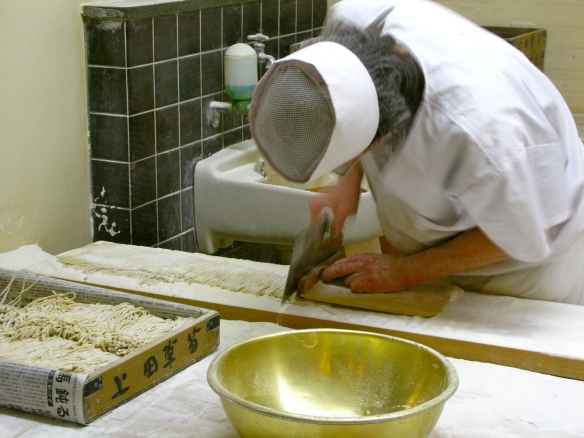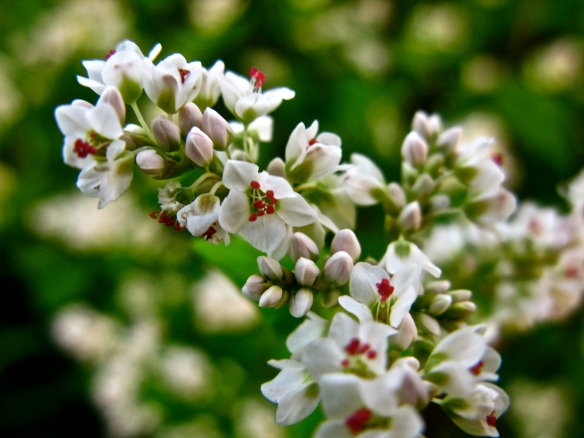By now, those of you who know me well (or who read this blog regularly) probably realize that I have a big crush on soba. While some foreigners who live in Japan become obsessed with ramen, ramen, and yet more ramen, I fell hard for soba. Not just any soba, but Shinshū soba (信州そば), which hails from mountainous Nagano prefecture in central Japan. (“Shinshū” refers to Shinano province, Nagano’s former name.) Why soba? It’s not a crowd pleaser like ramen, curry, or other Japanese favorites, perhaps due to its perception as “health food” in the west. While traditionally prepared soba noodles are indeed very healthy (high in protein and fiber, nearly devoid of animal products, and almost always accompanied by some sort of vegetable), this is not why they appeal to me. Rather, I am drawn to the painstaking process and ritual that surrounds their creation, their minimalist presentation, their hand-hewn texture and earthy flavor, and of course the sheer fun of slurping them up.
Buckwheat’s presence in Japan likely dates back to the Jōmon period (c. 10,000 – 300 B.C.), although whether it was actually widely consumed is a matter of debate. What does seem certain, however, is that it was cultivated out of necessity. Unlike rice, buckwheat is a fast-growing and hardy grain that thrives in poor, thin, mountainous soil (of which there is a great deal in Japan). Buckwheat was therefore a critical backup crop in areas where growing rice could be unpredictable at best or unsuccessful at worst.
Today, Nagano prefecture remains synonymous with buckwheat, and Shinshū soba is widely considered some of the best in Japan. The most common noodles, known as nihachi, are typically made with a 2:8 ratio of wheat to buckwheat flours, which produces a pleasingly rough, nubby, and rustic noodle. (The small amount of wheat flour helps bind the noodles, as buckwheat is gluten-free and therefore nearly impossible to wrestle into a cohesive dough.) One step higher in the soba hierarchy are jūwari noodles, which are made from 100% buckwheat. These are considerably darker and more strongly flavored, and, at least by some accounts, superior to nihachi and other varieties.
At Soba Alps in Matsumoto’s Asama Onsen neighborhood, customers can order three varieties of noodles, each made with different proportions of buckwheat flour. The shop’s staff will urge you to begin with the refined mizu soba (“water soba”), which are to be eaten after a quick dip in icy mountain spring water. From there, they’ll advise you to taste the two other noodles (nihachi and jūwari) first with water, then with a pinch of salt placed on the tip of your chopsticks. Then and only then should you begin dipping the noodles in tsuyu, the strong, soy sauce and dashi-based sauce that usually accompanies cold soba. (Below from left, “water” soba, nihachi soba, and jūwari soba.)
Regardless of the ratio used to make Shinshū soba, they are usually best enjoyed as zaru soba or mori soba, wherein cold noodles are dipped in tsuyu mixed with various spicy condiments, collectively known as yakumi. According to purists (including yours truly), this is best way to appreciate the delicate texture and subtle flavor of handmade soba.
At the Azumino branch of Kuruma-ya, the gossamer noodles are served alongside generous portions of sliced green onion and freshly grated, locally grown wasabi.
The noodles at Kuruma-ya’s main Kiso branch, on the other hand, are thicker, darker, and more complex. These hearty noodles can stand up to any topping, whether a simple garnish of shredded nori or a mass of grated mountain yam (tororo) topped with a raw, quivering quail egg.
Vegetable tempura is a common accompaniment to zaru soba that adds much-needed richness and heft to an otherwise lean meal. These noodles, from the Ueda branch of Kusabue, were admittedly not spectacular. Yet having seen the labor that went into making them, it was difficult to not appreciate them on some level.

Perhaps the best place to get a soba fix is at the annual Matsumoto soba festival. Every autumn, as the days grow shorter and summer’s bounty fades from memory, farmers across Nagano fell their buckwheat crop. In September, the fields are still a white carpet of tiny blooms.
By October, however, the plants have been culled and the land laid fallow. To celebrate the harvest, the city of Matsumoto hosts a three-day gathering of noodle producers and lovers from across the country. Two years ago, I was smitten by this bracing bowl of toothsome cold noodles with fresh Nagano-grown wasabi greens, green onions, and shichimi.
This year’s festival brought unusual variations, too, with accents like kaiware daikon (daikon radish sprouts) and crushed egoma (the seed of a shiso-like plant [Perilla frutescens var. frutescens], renowned for its medicinal qualities) finding a place among more common toppings like negi and fishcake.
Of all the soba I tried in Nagano, however, none were as comforting as the noodles at Inaka-ya, a small family-owned shop on the eastern outskirts of Matsumoto. I’ll say more about them in a later post, but suffice it to say that their noodles are fantastic. Made using a 9:1 ratio from flour milled in-house, they have the lovely, distinctly nutty flavor of freshly ground buckwheat and a delicate texture that belies their rusticity.
Kamo Nanban Soba / 鴨南蛮そば
(Soba noodles with duck)
Serves 2
This recipe comes by way of Harumi Kurihara’s Everyday Harumi, which offers a nice introduction to Japanese home cooking. The writing can be awkward at times, but the recipes are spot-on: simple, modern, and of course delicious. Gorgeous, muted photos printed on heavy matte paper make this book a pleasure to look at, too.
For this dish, I highly recommend making your own dashi from scratch. When it comes to soba (and most other Japanese dishes, for that matter), the quality of the seasoning is hugely important, because there are so few ingredients. Powdered dashi (dashi no moto) can be substituted here, but the result will not be particularly tasty. Homemade dashi is incredibly simple to make, so why not give it a try?
For the soup:
2 pieces konbu (dried kelp)
2-3 handfuls katsuobushi (bonito flakes)*
90 ml (about 1/3 cup) shōyu (Japanese soy sauce)
90 ml (about 1/3 cup) mirin
For the noodles:
200 grams (about 7 ounces) skin-on duck breast, thinly sliced against the grain**
10 medium or 15 large scallions, trimmed and cut into about 4 cm (1-1/2 inch) lengths
200 grams (about 7 ounces) dried soba noodles, preferably Shinshū soba (信州そば)
Shichimi tōgarashi, for garnish
For the soup:
First, make a simple dashi. Place the konbu in a large saucepan or stockpot and cover with 1.2 liters (about 5 cups) cold water. Let sit for 30 minutes. Set the pan over medium heat. Just before the water comes to a boil, remove the konbu and reserve, if desired, to make niban dashi (more on which below). Turn down the heat slightly and add the katsuobushi. Turn up the heat again. When the water comes to a boil, immediately turn off the heat and let the katsuobushi steep until they have settled to the bottom of the pan. Strain through a piece of cheesecloth or a clean kitchen towel into a bowl, reserving the katsuobushi if you’d like to make niban dashi.
Measure out 600 ml (about 2-1/2 cups) dashi into a saucepan and add the soy sauce and mirin. Bring to a simmer and add the duck. Continue cooking or a minute or two, skimming away any scum from the surface. Add the scallions and continue cooking until the duck is just cooked through and the scallions have softened. Cover and keep warm.
For the noodles:
Meanwhile, bring a large pot of unsalted water to a boil. Add the noodles and cook according to package instructions (usually about 5 minutes). Drain the noodles and divide between serving bowls. Ladle the hot soup mixture over the noodles and garnish with shichimi, if desired.
Notes:
*How much katsuobushi you use depends on how “fishy” you like your dashi. For this recipe, I would advise using about 2 handfuls.
**I usually trim away any excess fat, leaving the skin intact, but skinless is okay, too.
Niban dashi (literally, “second dashi”) is made using konbu and katsuobushi leftover from making ichiban dashi (“first dashi”). Niban dashi has a less delicate flavor than ichiban and is therefore better suited to simmered dishes and sauces, where the delicacy of ichiban dashi would be overpowered by other ingredients. To make niban dashi, take the reserved konbu and katsuobushi from a batch of ichiban dashi, place in a large saucepan, and cover with about 1.2 liters (6 cups) cold water. Place over medium heat. Just before the water comes to a boil, remove the konbu. Reduce heat and simmer for about 10 minutes. Add an additional handful of katsuobushi and remove from heat. Let sit until the katsuobushi have settled to the bottom of the pot. Strain through cheesecloth and store in fridge for up to 3 days or in freezer up to 1 week.

















Emma, I am a big fan of soba, too! It’s something I learned to appreciate as I got older. Thanks for this post—it’s inspired me to make some. Perfect for this cold weather!
Fab post — 100% buckwheat may be strong but a fit for Saul as he’s gluten free! Thanks for the post – Sue
@Azusa: Thanks for dropping by! Glad you liked the post. Are you able to find good dried or fresh soba noodles near you?
@Sue: Ah, I didn’t realize Saul was gluten free. In that case, soba definitely fits the bill!
Emma, I’ve been trying different brands… but haven’t come across a favorite yet. Do you have a particular brand you’d recommend? I’m looking for something with a nice koshi. Let me know!
Hi Azusa – In Japan, I’d often buy this brand: http://www.kirishina.jp/shop/detail.php?id=144#title It has a nice nubby texture and was readily available at most supermarkets, even outside Nagano. I haven’t seen it yet in NYC, but I wonder if you can find it in LA… Good luck, and let me know if you make any great discoveries!
Emma, thanks for the recommendation. I don’t remember seeing that one over here, but I’ll be sure to keep a closer eye the next time I’m at the store. I think I might see if they have frozen soba… will keep you posted! Thanks again!
look delicious….i need to try….
Pingback: Kurogoma Soba Noodles
I like the one with tororo – I’ve never had it this way, but I imagine it would be good.
Hi Emi – Thanks for stopping by! It was good, even though I’m not a huge fan of “neba neba”… Still, the textural contrast between the super-chewy soba, slippery tororo, and raw egg was pretty amazing!
I have just found your site. This soba post makes my stomach growl and want to go home!
Thanks for your comment, Emi! Soba is one of those rare foods with the capacity to both induce and cure homesickness, don’t you think?
Pingback: How to Eat in Japan « I am a viking.
Pingback: The Air Moon Ch. 2: Live House Tour Part 5 | E.V.A.'s Warped Frost
Pingback: My Soba So Good Experience in Japan - Kulture Kween
Pingback: How to Eat in Japan – I am a viking.
Pingback: How to Eat in Japan – I am a viking.